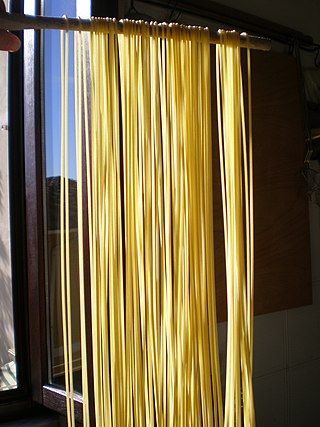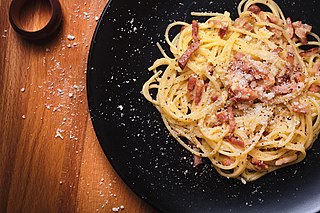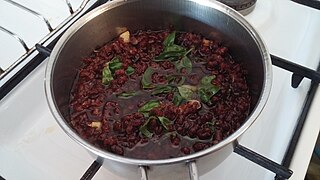Pasta ca nunnata is a pasta dish originating in the Sicily region of Italy prepared with newborn fish, which may be anchovies, sardines, red mullet or bream, as well as spaghetti, olive oil, garlic, parsley, white wine and black pepper. Sardines are most common and preferred, especially in the Palermo area. Where bream is used, the most common species is common pandora, known as luvari, uvari or luari in Sicilian. Tomatoes are sometimes added, but this is less common. The dish is also sometimes referred to as pasta ca sfighiata. [1] [2] [3] [4] [5]

Spaghetti is a long, thin, solid, cylindrical pasta. It is a staple food of traditional Italian cuisine. Like other pasta, spaghetti is made of milled wheat, water, and sometimes enriched with vitamins and minerals. Italian spaghetti is typically made from durum-wheat semolina. Usually the pasta is white because refined flour is used, but whole wheat flour may be added. Spaghettoni is a thicker form of spaghetti, while spaghettini is a thinner form. Capellini is a very thin spaghetti, while vermicelli refers to intermediate thicknesses.

Sicilian cuisine is the style of cooking on the island of Sicily. It shows traces of all cultures that have existed on the island of Sicily over the last two millennia. Although its cuisine has much in common with Italian cuisine, Sicilian food also has Greek, Spanish, French, Jewish, Maghrebi, and Arab influences.

Carbonara is a pasta dish made with fatty cured pork, hard cheese, eggs, salt, and black pepper. It is typical of the Lazio region of Italy. The dish took its modern form and name in the middle of the 20th century.

Arancini, also known as arancine, are Italian rice balls that are stuffed, coated with breadcrumbs and deep-fried. They are a staple of Sicilian cuisine. The most common arancini fillings are al ragù or al sugo, filled with ragù, mozzarella or caciocavallo cheese, and often peas, and al burro or ô burru, filled with prosciutto and mozzarella or béchamel sauce.

Spaghetti alla puttanesca is a pasta dish invented in Naples in the mid-20th century and made typically with tomatoes, olives, capers, anchovies, garlic, peperoncino, extra virgin olive oil and salt.

Italian cuisine is a Mediterranean cuisine consisting of the ingredients, recipes, and cooking techniques developed in Italy since Roman times and later spread around the world together with waves of Italian diaspora. Significant changes occurred with the colonization of the Americas and the introduction of potatoes, tomatoes, capsicums, maize, and sugar beet—the latter introduced in quantity in the 18th century. It is one of the best-known and most appreciated gastronomies worldwide.

Neapolitan cuisine has ancient historical roots that date back to the Greco-Roman period, which was enriched over the centuries by the influence of the different cultures that controlled Naples and its kingdoms, such as that of Aragon and France.

Spaghetti aglio e olio is a pasta dish typical of the city of Naples, in the Campania region of Italy. It is a typical dish of Neapolitan cuisine and is widely popular. Its popularity can be attributed to it being simple to prepare and the fact that it makes use of inexpensive, readily available ingredients that have long shelf lives in a pantry.

Macaroni cheese pie is a casserole dish based on baked macaroni and cheese. Primary ingredients may include elbow macaroni, cheese, and milk.

Bolognese sauce, known in Italian as ragù alla bolognese or ragù bolognese, is a meat-based sauce in Italian cuisine, typical of the city of Bologna. It is customarily used to dress tagliatelle al ragù and to prepare lasagne alla bolognese.

The traditional cuisine of Abruzzo is eclectic, drawing on pastoral, mountain, and coastal cuisine. Staples of Abruzzo cuisine include bread, pasta, meat, fish, cheese, and wine. The isolation which has characterized the region for centuries has ensured the independence of its culinary tradition from those of nearby regions. Local cuisine was widely appreciated in a 2013 survey among foreign tourists.

Pasta con le sarde is a Sicilian pasta dish with sardines and anchovies. It is recognized as a traditional Italian food product in the prodotto agroalimentare tradizionale (PAT) scheme of the Italian government. It is most associated with the city of Palermo, but it can be found all over the island.

The capuliato or capuliatu is a traditional condiment of Sicilian cuisine based on dried tomatoes, linked, in particular to the territory of the Vittoria Plain, in free municipal consortium of Ragusa. The original name is capuliato, meaning 'minced'.
Pasta â Paolina is a pasta dish originating in the city of Palermo, Sicily. It was invented by a friar at the Monastery of San Francesco di Paola. Friars avoid meat consumption due to their traditional vow of poverty, so this dish is pescatarian and utilizes minimal ingredients. Traditionally it used bucatini, but now spaghetti is often used. It is made with anchovies, garlic, a small amount of chopped tomato, cinnamon, cloves, almonds, basil, and breadcrumbs.
Pasta chi vrocculi arriminati is a pasta dish originating in the Palermo region of Italy. It generally consists of a long pasta such as spaghetti or bucatini, cauliflower, onion, raisins, anchovies, pine nuts, saffron, red chili, and breadcrumbs. Traditionally, it was made with bucatini. The name arriminati means 'mixed' and refers to the process of mixing until the cauliflower forms a creamy sauce.
Pasta 'ncasciata is a celebratory baked pasta dish originating in the Sicilian comune (municipality) of Messina; however, today there are numerous versions from every province of Sicily and Calabria. Ingredients vary according to the region as well as personal preferences. For example, while the dish usually uses two types of cheese, béchamel sauce may be used in lieu of one of the cheeses. It was traditionally baked in a dish placed over, as well as covered by, hot coals. The dish was made more well known by Andrea Camilleri's Inspector Montalbano.

Spaghetti alla carrettiera is a pasta dish originating in the Platani Valley, nowadays more common in eastern Sicily. It is generally made with spaghetti, garlic, chili pepper, pecorino siciliano or breadcrumbs, parsley, and olive oil for dressing, and commonly tomato is added. Sometimes additional ingredients such as anchovies, capers, almonds or pine nuts and white wine are also included. The oral tradition is that the pasta dish originated with carters who brought the dish prepared in advance, on their wagons for lunch.

Spaghetti alla siracusana, also known as pasta fritta alla siracusana, is a pasta dish typical of Syracuse cuisine, widespread throughout Sicily.